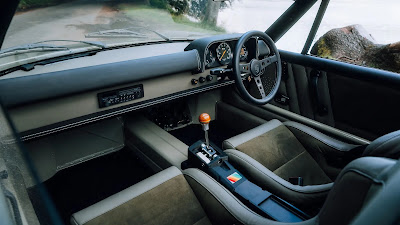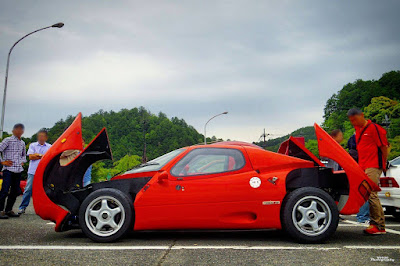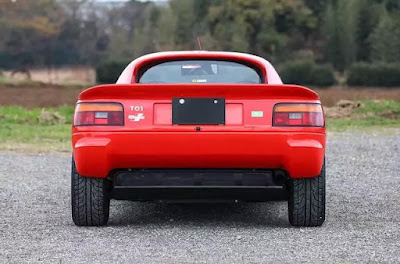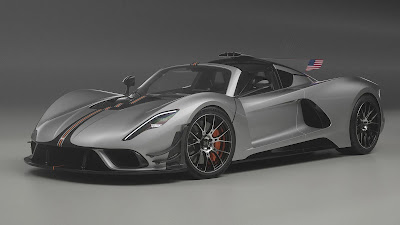Unique RestoMod - Restoring classic cars has always been a way to bring the past into the present while adding a modern touch, and Fifteen Eleven Design has taken this art form to a whole new level. Nearly three years after announcing their ambitious project, the renowned car builders and restoration experts have opened the doors for enthusiasts to place their orders for a modern recreation of the beloved Porsche 914. With this new creation, Fifteen Eleven Design breathes new life into an air-cooled classic, blending contemporary engineering with the timeless appeal of the original car.
 |
| Fifteen Eleven Design breathes new life into the legendary Porsche 914, blending contemporary engineering with the timeless appeal of the original classic. (Picture from: TopGear) |
Based in the scenic town of Bakewell, Derbyshire, Fifteen Eleven Design is part of the prestigious Mellors Elliot Motorsport family. With a history deeply rooted in the World Rally Championship, Mellors Elliot Motorsport boasts an impressive 12 FIA World Rally Championship titles. This expertise and passion for performance have translated into several exciting projects, such as recommissioning the iconic Alan Jones’ Williams FW07/04 F1 car, crafting a Restomod version of the Ford Escort MK1 Speedster, and rebuilding a Maserati 3500 GT Inezione that earned a runner-up position at the Salon Privé. Now, the team’s skills are showcased in their Porsche 914 Restomod, which was first introduced to the world in 2021 to widespread praise.
 |
| This Porsche 914 Restomod is a complete reimagining that seamlessly fuses the car's original spirit with cutting-edge modern features. (Picture from: TopGear) |
This Porsche 914 Restomod is far from a simple restoration. It’s a thorough reimagining that carefully blends the car’s original spirit with advanced modern features. Using a Porsche 987 Cayman S as its base, this mid-engined, Targa-topped roadster comes alive with a 3.8-liter, six-cylinder boxer engine, delivering the classic Porsche roar that enthusiasts love. Extensively reworked, this engine is now capable of producing between 380 and 400 horsepower—more than three times the power of the original model. Steel internals, forged pistons, and a state-of-the-art Life Racing ECU ensure that this car is as powerful as it is reliable.
 |
| Built on a Porsche 987 Cayman S, this mid-engined, Targa-topped roadster features a 3.8-liter six-cylinder boxer engine, delivering the iconic Porsche roar. (Picture from: TopGear) |
Paired with a 6-speed transmission, the driving experience is smooth and responsive, offering exceptional performance across the rev range. Handling is enhanced by Reiger three-way adjustable coil-over shock absorbers, which are typically found on World Rally Cars, giving drivers a taste of rally-level performance on the road. The suspension, based on the Cayman’s architecture, adds stability and control, ensuring an unforgettable driving experience.
Braking is just as impressive, thanks to Porsche Brembo four-piston calipers and cross-drilled, vented discs. This setup, combined with a floor-mounted AP Racing pedal box, ensures that stopping power is both strong and precise. To further enhance safety and performance, the car features a custom-made fuel cell with an FIA-compliant bladder, a detail that nods to the firm’s motorsport heritage.
 |
| Inside, the Porsche 914 Restomod impresses with its luxurious leather-draped cabin, Recaro seats for comfort and style, re-engineered bulkhead for extra legroom, and meticulously crafted cockpit that balances functionality with beauty. (Picture from: TopGear) |
The bespoke nature of this vehicle extends beyond its performance features. From a fly-by-wire throttle system to a stainless-steel exhaust, every element of the car is carefully crafted. Rolling on 18-inch Fuchs wheels wrapped in Michelin Pilot Sport 2 tires, this Porsche 914 not only looks stunning but handles with precision.
While the car’s exterior retains the Porsche 914’s iconic look, it has undergone significant upgrades. The chassis has been reworked, with suspension pick-up points redesigned to accommodate the Cayman-based architecture. The body has been strengthened, with T45 tubular chassis structural reinforcement enhancing rigidity. The vehicle’s carbon fiber body panels have been widened, giving it a bolder appearance. A redesigned bonnet and bumper improve cooling, and a rear ducktail spoiler adds an aggressive edge. LED projector headlights light the way, while distinctive “Moby Dick” style driving lights offer a unique flair.
 |
| The bespoke design of this vehicle includes a redesigned bonnet and bumper for improved cooling, a rear ducktail spoiler for an aggressive touch, and distinctive LED projector headlights with "Moby Dick" style driving lights for added flair. (Picture from: TopGear) |
Inside, the Porsche 914 Restomod is just as impressive. The cabin is draped in luxurious leather, and the Recaro seats provide both comfort and style. With a re-engineered bulkhead, the interior offers extra legroom, making it a more practical and comfortable space for drivers. Every detail of the cockpit has been designed with care, ensuring that this recreation of a classic car is as functional as it is beautiful.
Each of these custom-built cars is created to meet the specific desires of the customer. From color choices to trim options, buyers can personalize their vehicle to suit their taste. Available in both left- and right-hand drive, this Porsche 914 Restomod is sure to capture the hearts of classic car lovers everywhere.
 |
| The bespoke nature of this vehicle goes beyond performance, with every element, from the fly-by-wire throttle to the stainless-steel exhaust, meticulously crafted. (Picture from: TopGear) |
The road to creating the Fifteen Eleven Design Porsche 914 has been long and challenging, but the result speaks for itself. Ben Mellors, Managing Director of Fifteen Eleven Design, expressed his pride in the project, stating that the vision has finally come to life. While the process took longer than expected, Mellors emphasized that their dedication to achieving perfection in every aspect of the build was worth the wait. The final product is not only stunning to look at but also thrilling to drive, combining the best of modern technology with the timeless elements of classic car design.
 The Fifteen Eleven Design Porsche 914 Restomod is now ready for the world to experience. Years of hard work and passion have culminated in a vehicle that showcases the best of both the old and the new. As order books open, car enthusiasts are invited to be part of this extraordinary journey, owning a piece of history that’s been reimagined for the modern age. *** [EKA | FROM VARIOUS SOURCES | FIFTEEN ELEVEN DESIGN | TOPGEAR | ALPHABET ]
The Fifteen Eleven Design Porsche 914 Restomod is now ready for the world to experience. Years of hard work and passion have culminated in a vehicle that showcases the best of both the old and the new. As order books open, car enthusiasts are invited to be part of this extraordinary journey, owning a piece of history that’s been reimagined for the modern age. *** [EKA | FROM VARIOUS SOURCES | FIFTEEN ELEVEN DESIGN | TOPGEAR | ALPHABET ]Note: This blog can be accessed via your smart phone








































